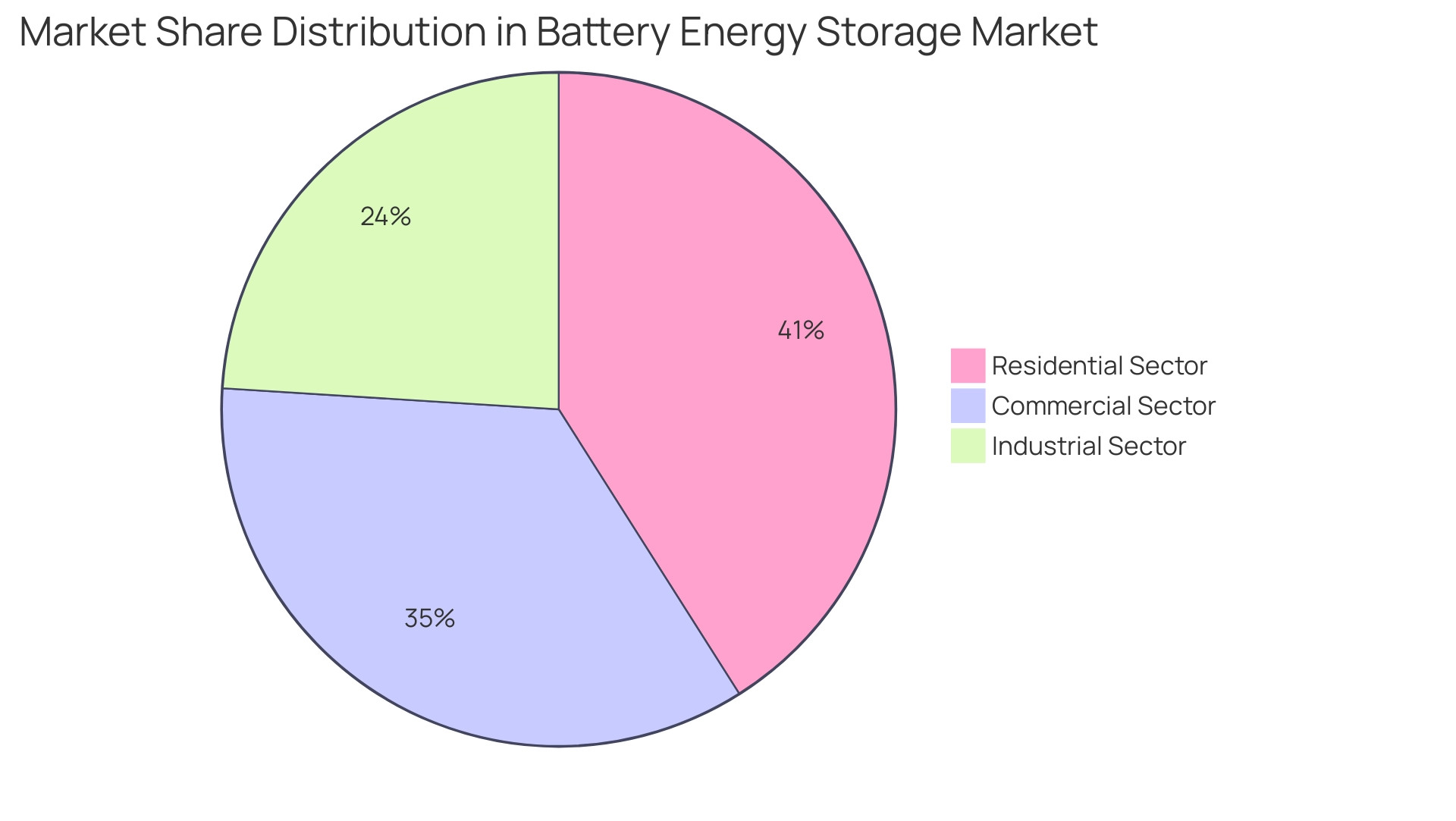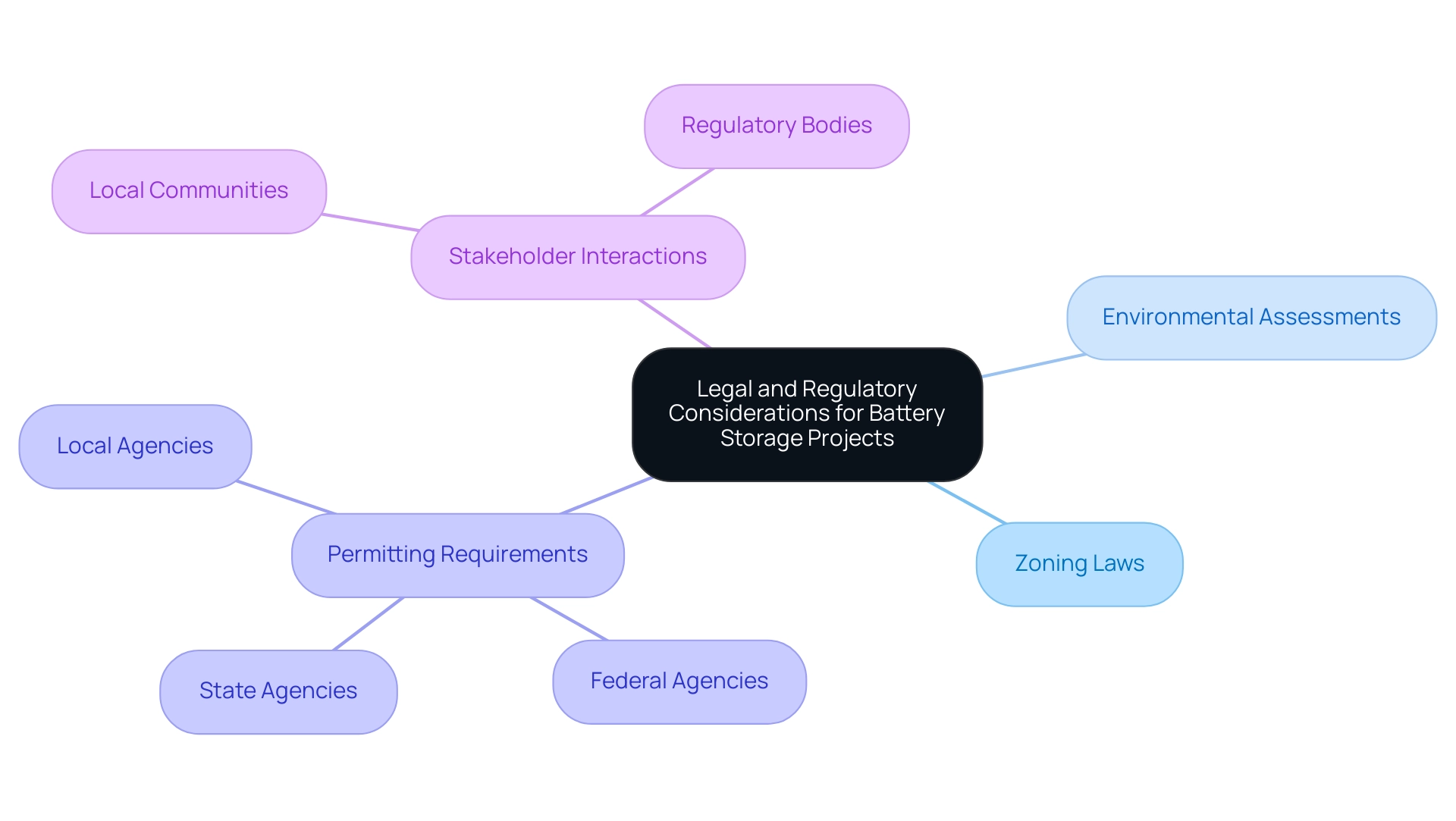Introduction
The transition to renewable energy sources has underscored the critical role of battery storage systems in ensuring energy reliability and grid stability. As the demand for efficient energy storage solutions escalates, understanding the intricacies of battery storage land data services becomes essential. These services not only facilitate the identification and acquisition of suitable land but also navigate the complex legal and regulatory landscapes that govern such projects.
With the battery energy storage market projected to experience significant growth in the coming years, organizations must strategically position themselves to capitalize on emerging opportunities while addressing the challenges posed by urbanization and regulatory hurdles. This article delves into the various facets of battery storage land data services, exploring technological innovations, market dynamics, and the importance of legal compliance in driving successful energy storage initiatives.
Understanding Battery Storage Land Data Services in Renewable Energy
Battery storage land data services involve a complete range of services that support the identification, acquisition, and management of locations for battery power systems. These services encompass:
- Site selection
- Usage analysis
- Title research
- GIS mapping
All of which are essential for ensuring that power reserve projects are developed on appropriate and legally compliant locations. As renewable power sources such as wind and solar become more common, the demand for effective resource preservation methods has increased, rendering these services progressively vital.
By utilizing advanced technologies and data analytics, data services assist in streamlining the process of securing rights, thereby enabling the prompt deployment of power systems that improve grid stability and reliability.
Opportunities and Strategic Positioning in the Battery Energy Storage Market
The accumulator power reserve market is set for significant expansion, with a compound annual growth rate (CAGR) of 20.88% expected from 2024 to 2032. This expansion presents substantial opportunities across commercial, industrial, and residential sectors. In fact, the residential sector dominated the market with over 41% share in 2023, driven by the increasing popularity of solar power and falling storage prices.
As power requirements vary and the incorporation of renewable sources becomes more common, the need for efficient battery storage land data services intensifies. Organizations that strategically position themselves within this market can benefit by offering innovative energy solutions, including battery storage land data services, tailored to the unique requirements of their clients. For instance, commercial organizations may pursue large-scale holding systems to effectively manage peak demand, while residential clients increasingly seek solutions to enhance power independence and reduce utility costs.
Recent advancements, such as Tesla's launch of the Megapack in April 2023 and Fluence Energy's introduction of a new energy platform in August 2023, reflect the latest innovations in commercial energy solutions. As one of the largest companies in the defense industry noted, 'Thank you for sending the market report and data. It looks quite comprehensive and the data is exactly what I was looking for.
I appreciate the timeliness and responsiveness of you and your team.' By remaining attuned to market trends and leveraging emerging technologies, companies can cultivate competitive advantages in battery storage land data services that not only address current challenges but also strategically prepare for future demands in an evolving landscape. Moreover, comprehending market segmentation by cell type, connection type, and ownership will offer a thorough insight into the energy reserve market.

Legal and Regulatory Considerations for Battery Storage Projects
Legal and regulatory factors play a crucial role in the successful execution of energy reserve projects. These considerations encompass:
- Zoning laws
- Environmental assessments
- Permitting requirements that vary by region
For instance, securing the necessary permits often involves navigating complex regulatory environments that can include federal, state, and local agencies.
Additionally, compliance with environmental regulations is critical, as projects must demonstrate minimal impact on local ecosystems. Organizations must interact with stakeholders, including:
- Local communities
- Regulatory bodies
to ensure transparent communication and address any concerns regarding usage and environmental impact. By understanding and effectively managing these legal frameworks, companies can reduce project risks and enhance their reputation within the industry.

Technological Innovations in Battery Storage Land Data Services
Technological advancements have significantly transformed energy conservation and data services, resulting in more effective and accurate operational processes. Geographic Information Systems (GIS) play a pivotal role in this transformation, facilitating intricate usage analysis that empowers consultants to identify optimal sites for battery storage land data services projects, considering both geographic and environmental factors. Jack Dangermond, who earned both a Bachelor's and a Master's degree in landscape architecture from Harvard University, asserts,
GIS is a tool that can help us build a more sustainable and resilient future.
This sentiment underscores the vital role GIS plays in enhancing decision-making processes. For instance, case studies have demonstrated how GIS technology has been utilized in energy project site selection, leading to more informed property acquisition strategies. Furthermore, the emergence of AI-driven title research software greatly enhances the speed and precision of title searches, reducing the time needed to obtain property rights.
These advancements not only streamline project timelines but also enhance the reliability of battery storage land data services, enabling organizations to make well-informed decisions regarding property acquisition. As the sector advances, embracing these technological innovations will be essential for sustaining a competitive edge in the swiftly changing energy reserve market. Additionally, the importance of maps and GIS in understanding complex spatial relationships cannot be overstated, as they provide critical insights that inform strategic planning and decision-making.
Challenges Facing Battery Storage Land Data Services
The battery storage market offers substantial growth prospects; however, it encounters a multitude of challenges that can impede the effectiveness of battery storage land data services. Urbanization presents a significant challenge, as rising competition for appropriate space often emerges from usage conflicts, thereby limiting feasible options for development. For instance, recent statistics indicate that usage conflicts have led to a 30% increase in project delays in urban areas, complicating acquisition efforts.
Compounding this issue is the regulatory landscape, characterized by lengthy approval processes that can severely delay project timelines. Moreover, stakeholder engagement remains critical; varying interests among landowners, community members, and regulatory bodies frequently lead to conflicts requiring resolution. To navigate these complexities, organizations must implement robust strategies that incorporate battery storage land data services, along with proactive communication, comprehensive market analysis, and adept negotiation techniques.
By anticipating and addressing potential challenges, companies can significantly enhance their chances of successfully implementing projects related to battery storage land data services. This proactive approach is especially pertinent given recent news, such as TUSCO Limited's announcement about bids for consultants to investigate floating solar power in Uttar Pradesh, which underscores the increasing competition for land resources in the sector. Furthermore, future advancements in power storage are anticipated to emphasize low cost, high density, and long-term storage capabilities, which are critical for enhancing the viability of battery storage systems.
Additionally, advancements in operational techniques, such as the use of robots for cleaning solar modules, can improve efficiency and reduce maintenance costs, further supporting the successful execution of energy projects.
Conclusion
Battery storage land data services are increasingly vital in the renewable energy transition. These services encompass essential functions such as:
- Site selection
- Land use analysis
- Legal compliance
These functions are crucial for the successful deployment of energy storage systems. As the demand for reliable energy solutions grows, technological advancements like GIS and AI are streamlining land acquisition and improving decision-making.
The battery energy storage market is set for significant growth, presenting substantial opportunities across residential, commercial, and industrial sectors. Organizations that strategically align with market trends and customer needs will be well-positioned to succeed in this evolving landscape.
Nonetheless, navigating complex legal and regulatory frameworks poses challenges. Companies must manage:
- Zoning laws
- Environmental assessments
- Stakeholder engagement
to mitigate risks and enhance their reputation. Addressing these elements effectively is essential for the successful execution of battery storage projects.
In summary, leveraging innovative technologies and proactively addressing regulatory challenges are critical for capitalizing on the expanding battery energy storage market. By efficiently managing land data services, organizations can contribute significantly to enhancing energy reliability and supporting a sustainable energy future.
Frequently Asked Questions
What services are included in battery storage land data services?
Battery storage land data services include site selection, usage analysis, title research, and GIS mapping, all essential for developing power reserve projects on suitable and legally compliant locations.
Why are battery storage land data services becoming increasingly important?
As renewable energy sources like wind and solar become more prevalent, the demand for effective resource preservation methods has risen, making these services vital for managing battery storage projects.
How do data services support the deployment of power systems?
Data services utilize advanced technologies and data analytics to streamline the process of securing rights for locations, enabling quicker deployment of power systems that enhance grid stability and reliability.
What is the projected growth rate for the accumulator power reserve market?
The accumulator power reserve market is expected to grow at a compound annual growth rate (CAGR) of 20.88% from 2024 to 2032.
Which sector dominated the battery storage market in 2023?
The residential sector dominated the battery storage market in 2023, holding over 41% of the market share, driven by the increasing popularity of solar power and decreasing storage costs.
What role do legal and regulatory factors play in energy reserve projects?
Legal and regulatory factors, including zoning laws, environmental assessments, and permitting requirements, are crucial for the successful execution of energy reserve projects and can impact project timelines.
How do Geographic Information Systems (GIS) contribute to battery storage land data services?
GIS facilitates detailed usage analysis, helping consultants identify optimal sites for battery storage projects by considering geographic and environmental factors, thus enhancing decision-making processes.
What challenges does the battery storage market face?
The battery storage market faces challenges such as urbanization leading to competition for space, lengthy regulatory approval processes, and stakeholder engagement conflicts, which can delay project timelines.
What strategies can organizations implement to overcome challenges in battery storage land data services?
Organizations can enhance their chances of successful project implementation by employing proactive communication, comprehensive market analysis, adept negotiation techniques, and robust strategies that incorporate battery storage land data services.
List of Sources
- Opportunities and Strategic Positioning in the Battery Energy Storage Market
- fortunebusinessinsights.com (https://fortunebusinessinsights.com/industry-reports/battery-energy-storage-market-100489)
- Battery Energy Storage System Market to Cross USD 54.28 Billion at 26.61% CAGR by 2032, Driven by Renewable Energy Adoption | Report By SNS Insider (https://globenewswire.com/news-release/2024/09/24/2952314/0/en/Battery-Energy-Storage-System-Market-to-Cross-USD-54-28-Billion-at-26-61-CAGR-by-2032-Driven-by-Renewable-Energy-Adoption-Report-By-SNS-Insider.html)
- Technological Innovations in Battery Storage Land Data Services
- 30 Best Jack Dangermond Quotes With Image | Bookey (https://bookey.app/quote-author/jack-dangermond)
- Challenges Facing Battery Storage Land Data Services
- Storage Support: Strengths and challenges of BESSs and PSPs in the Indian context - Renewable Watch (https://renewablewatch.in/2024/09/26/storage-support-strengths-and-challenges-of-besss-and-psps-in-the-indian-context)




